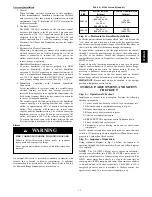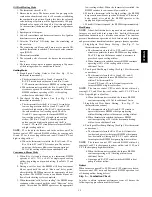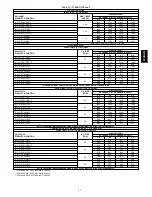
16
1. On a new installation, air entrapped in oil line leading from
tank to nozzle must be thoroughly purged in order to
prevent excessive after drip. The oil pump is provided with
a special fitting which allows purging of any air between
tank and oil pump. The proper procedure for performing
this operation is as follows:
a. Place a piece of clear plastic 1/4--in. (6 mm) diameter
tubing over purge fitting on oil pump.
b. Start oil burner, then open purge fitting and allow burn-
er to run until purge tube is completely free of air
bubbles.
c. Tighten purge fitting. Allow oil to run to nozzle and
fire burner.
d. If purging takes longer than 15 sec. and no flame has
been established, burner stops. Push reset button on
front of primary control to restart burner.
e. For detailed information on operation of primary con-
trol, refer to burner instructions included with furnace.
2. The oil pressure regulator is factory set to give oil pressure
of 135 psig for the model having 105,000 BTUH input and
130 psig for the model having 119,000 BTUH input. The
firing rate noted on nameplate may be obtained using the
nozzles and pump pressures indicated in Table 6. The prop-
er oil burner turbulator setting for all the firing rates is 0
(zero).
3. A test kit to measure smoke, stack draft, over--fire draft,
CO2, oil--pump pressure, and stack temperatures MUST be
used in order to obtain proper air band setting.
4. The proper smoke number has been established by
engineering tests to be between 0 and 1. This degree of
smoke emission is commonly referred to as a “trace” of
smoke. It is recommended to use a Bacharach true--spot
smoke test set or equivalent.
a. Pierce a test hole in the flue pipe, approximately 18 in
(457 mm) from the furnace breech.
b. Insert the smoke test probe into the hole. For installation
using sidewall venting, use the orifice provided on the
breech plate.
c. From a cold start, let the unit operate for 5 minutes.
d. Adjust the burner air setting to achieve between 0 and 1
on the Bacharach Scale(or a trace);
e. Take a CO2 sample at the same test location where the
#1 smoke reading was taken and make note of it.
Example: 13.8% of CO2 or 2.5% of O2.
f. Adjust the burner air setting to obtain a: -- CO2 reading
1.5% lower or -- a O2 reading 2.0% higher than the
reading associated with the #1 smoke.
Example: 12.3% of CO2 or 4.5% of O2;
g. This method of adjusting the burner will result in clean
combustion (Smoke reading from the Bacharach scale
between 0 and a trace) and ensure the proper
functioning of the system.
5. In order to ensure proper draft through furnace, a barometric
draft regulator (supplied with furnace) must be installed.
In order for this device to function properly, barometric damper
must be mounted with hinge pins horizontal and face of damper
vertical. (See instructions included with damper.) The draft
regulator should be adjusted after furnace has been firing for at
least 5 min., and set between --0.025 and --0.035 in. wc. (See Table
5.)
Table 5 – Furnace Draft Conditions (in wc)
FURNACE
INPUT
(BTUH)
FLUE DRAFT
MINIMUM
OVER---FIRE DRAFT
MAXIMUM
TOTAL
RESTRICTION
THROUGH HEAT
EXCHANGER
70,000
---0.025
0.010
0.020 to 0.035
91,000
---0.025
0.020
0.030 to 0.045
105,000
---0.025
0.025
0.035 to 0.050
119,000
---0.025
0.025
0.035 to 0.050
140,000
---0.025
0.025
0.035 to 0.050
154,000
---0.025
0.025
0.035 to 0.050
6. The over--fire draft, which is taken through observation
door (located in center line above burner in front panel of
furnace), is a measurement necessary to determine if there is
a blockage between oil burner and flue outlet.
There should be a total pressure drop of between 0.020 and
0.05 in. wc. through furnace as shown in Table 5. The over--
fire draft must be set within the range shown in Table 5.
A reading outside the range shown in Table 5 (for example
+0.1 in. wc.) would indicate that furnace is in an extremely
high--pressure condition in primary section. This condition
may be caused by any of the following problems:
a. Excessive combustion air due to air band being too
wide open.
b. A lack of flue draft (chimney effect) or some other
blockage, such as soot, in secondary section of heat
exchanger.
c. Use of an oversized nozzle input.
d. Pump pressure over the values listed in Table 6.
7. After having adjusted the burner combustion, insert a ther-
mometer into the test hole in the breech pipe. The vent tem-
perature should be between 400 and 535
_
F (204 and 302
_
C). If not, check for improper air temperature rise, pump
pressure, nozzle size or a badly soiled heat exchanger.
Table 6 – Burner Input and Nozzle Size
FURNACE
INPUT
(BTUH)
FIRING RATE
GAL/HR (US)*
RIELLO OIL BURNER
PUMP
PRESSURE
(PSIG)
NO. 40
SERIES
MODEL
DELAVAN
NOZZLE
70,000
0.50
F3
0.40 -- 70A
160
91,000
0.65
F3
0.50 -- 70W
170
105,000
0.75
F3
0.65 -- 70W
135
119,000
0.85
F5
0.75 -- 70B
130
140,000
1.00
F5
0.85 -- 70W
140
154,000
1.10
F5
1.00 -- 70W
125
* For rating purposes only.
Additional information on the operation and adjustment of burner
can be found in the burner manual, included with the furnace.
After all the setup procedures mentioned above have been
completed, the burner should be allowed to operate and an
inspection mirror should be used to observe the flame pattern at tip
of nozzle. Any irregularities such as burning to 1 side or pulsating
flame patterns should be corrected by changing nozzle.
Step 4 — Fan Adjustment Check
This furnace is equipped with a variable--speed motor. The blower
is factory set to deliver the required airflow for 0.75GAL/HR(US)
INPUT and 3.0 tons air conditioning for the 374RAN105 (See
Tables 7, 8, and 9 and Fig. 19.). The blower is factory set to deliver
the required airflow for 0.85GAL/HR (US) INPUT and 5 tons air
conditioning for the 374RAN120. (See Tables 10, 11 and 12 and
Fig. 19.) The blower is field adjustable to deliver the required
airflow for other capacities.
374RAN







































